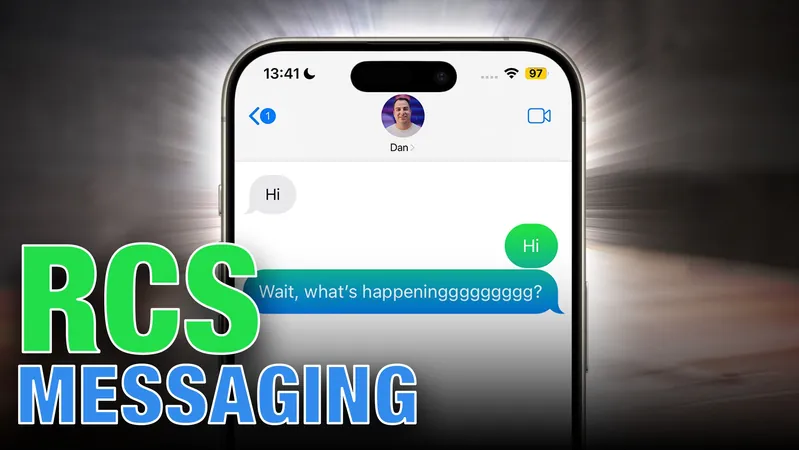
Unlocking a New Era: RCS Messaging Now Available on iPhone!
2024-11-25
Author: Jessica Wong
Unlocking a New Era: RCS Messaging Now Available on iPhone!
Apple has finally lifted the curtain on Rich Communication Services (RCS) with the release of iOS 18, marking a transformative shift in the way iPhone users communicate with Android counterparts. Dubbed as "SMS 2.0," RCS significantly enhances the messaging landscape by providing a more interactive and efficient experience compared to traditional text messaging.
Why RCS is a Game Changer for Messaging
Following persistent advocacy from Google, which has been a strong proponent of RCS worldwide, Apple’s adoption comes with exceptional features that elevate cross-platform messaging. Users can now expect:
Superior Media Quality
Send and receive higher resolution photos and videos without the limitations of traditional SMS.
Expanded Attachment Limits
Enjoy the luxury of sending larger file sizes effortlessly.
Diverse Messaging Options
Audio messages and improved group chat functionalities are now at your fingertips.
Enhanced Communication Indicators
Know when your messages have been read or when the other party is typing.
Increased Security
Benefit from stronger encryption when chatting with Android users.
Location Sharing
Easily share your location through text threads.
Connectivity Flexibility
RCS can be utilized over both cellular data and Wi-Fi.
Understanding the Differences: RCS vs. iMessage
While iMessage offers a host of features exclusive to Apple users, RCS aims to bridge the communication gap between different operating systems. Yes, sending messages to Android users will still show up as green bubbles in Apple's Messages app, but they will now be labeled as "Text Message – RCS," clearly identifying them as enhanced messages.
RCS brings many of the familiar capabilities of iMessage to cross-platform communication, such as high-quality media and conversational cues, effectively enriching the text messaging experience. However, it’s essential to note that iMessage remains superior in terms of security with its end-to-end encryption feature, which RCS does not fully replicate.
Availability is another crucial factor to consider; while iMessage is seamlessly integrated across all Apple devices, RCS is contingent on carrier support. Fortunately, major U.S. carriers—including Verizon, T-Mobile, and AT&T—have already begun to support RCS.
So, What Can You Expect When Messaging Across Devices?
Improved Media Quality: Bye-bye pixelation! High-resolution photo and video sharing is now the norm.
Interactive Messaging: View typing indicators and read receipts for more engaged conversations.
Enhanced Group Chats: Organizing groups with iPhone and Android friends becomes effortless with streamlined functionalities.
Wi-Fi Messaging Features: Send messages even when cellular connectivity fails.
Fallback Messaging Options: If RCS is unavailable, your messages will seamlessly revert to SMS/MMS, maintaining communication continuity.
How to Activate RCS on Your iPhone
Enabling RCS is straightforward, but ensure that your carrier supports it:
1. Open the **Settings** app on your iPhone.
2. Scroll down to **Apps**.
3. Tap on **Messages**.
4. Under **Text Messaging**, select **RCS Messaging** and toggle it to the ON position.
If you do not see this option, check Apple’s official support page for a list of compatible carriers.
Identifying RCS Messages
To verify you are using RCS in the Messages app, look for the "RCS" label at the top of your conversation window when texting someone not on an Apple device.
Looking Forward: The Future of RCS
Apple is not just stopping with RCS implementation; the tech giant plans to collaborate with Google and the Global System for Mobile Communications Association (GSMA) for further enhancements. Future updates could include exciting features like the ability to edit or delete sent messages, enhancing functionality even further.
This move not only revolutionizes iPhone messaging but also signals a commitment to reducing barriers in communication technology—empowering users with richer interactions, regardless of their device ecosystems. Stay tuned!


 Brasil (PT)
Brasil (PT)
 Canada (EN)
Canada (EN)
 Chile (ES)
Chile (ES)
 España (ES)
España (ES)
 France (FR)
France (FR)
 Hong Kong (EN)
Hong Kong (EN)
 Italia (IT)
Italia (IT)
 日本 (JA)
日本 (JA)
 Magyarország (HU)
Magyarország (HU)
 Norge (NO)
Norge (NO)
 Polska (PL)
Polska (PL)
 Schweiz (DE)
Schweiz (DE)
 Singapore (EN)
Singapore (EN)
 Sverige (SV)
Sverige (SV)
 Suomi (FI)
Suomi (FI)
 Türkiye (TR)
Türkiye (TR)